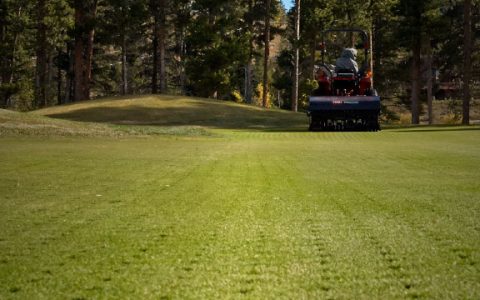If youre a golf course owner or operator, you cant afford to ignore aerification. Its essential to maintain healthy turf.
Aerification is one of the most valuable turf management practices for golf courses. It can help address challenges like soil compaction, layering in the soil profile, poor drainage, poor gas exchange, thatch, the need to modify heavy soils in the root zone, and the need to improve the establishment of sod or overseeding. The key is to choose the right method(s) to match the problem you need to overcome.
Key Considerations
Specific problems develop at different times of the growing season. Periods of heavy field use result in high levels of wear and compaction. And high summer temperatures amplify the need for gas exchange in the root zone to replenish soil oxygen and remove carbon dioxide.
In addition, aerification imposes a temporary stress on turf. Speed of recovery from aerification is linked closely to weather conditions and to the stage of the annual growth cycle for different species of turf. Keep these factors in mind when you decide on your aerification plan.
Heres a quick look at five different aerification processes and some basic recommendations for each:
Core Aerification: The Most Versatile
Core aerification addresses several turf and soil issues at once. Core aerification followed by core removal and sand topdressing is the best method of controlling the buildup of undecomposed organic matter in the root zone in sand-based soils. Removing soil this way can also reduce bulk density or compaction, particularly in fine-textured soils.
In the process, gas exchange is improved and drainage channels are created for improved water movement. The cores of soil brought to the surface can also be pulverized and incorporated back into the thatch layer as topdressing. In addition, core removal followed by sand topdressing allows for the permanent modification of the root zone soil profile over time.
Core aerification does impose a temporary but significant wounding stress on turf by opening the canopy and removing a portion of the root mass. Open holes in the root zone also speed soil drying, especially if done during hot and windy weather. As a result, its critical to core aerify at a time during the growing season when the turf is growing vigorously to offset the injury and speed healing. Cool-season turf species are best core aerified in the spring and fall during active growth. Warm-season turf species, however, are best core aerified between late spring and early fall when the turf is actively growing. In both cases, fall aerification should occur early enough to provide sufficient recovery time before active growth subsides.
Solid Tine Aerification
Solid tine aerification enhances gas exchange between the root zone and the atmosphere. It is a particularly useful practice during periods when turf is stressed and root respiration is high, increasing demand for O2 and causing an accumulation of CO2 in the root zone.
Although solid tine aerification causes less injury to the turf than hollow tines and is an effective solution for increasing soil gas exchange, it does not reduce compaction since no soil is removed. Soil bulk density actually increases slightly in the vicinity of the aerification hole as the tine compresses the soil around it upon entry.
Slicing and Spiking
Slicing and spiking are similar to solid time aerification, as the primary benefit is to improve gas exchange by creating channels into the root zone. Both are generally shallow treatments and cause minimal injury to the turf.
Deep Tine Aerification: Breaks Up Compaction
Deep tine aerification to depths up to 16 inches using both solid and hollow tines has become increasingly popular as a way of breaking through deep layers of compaction. Repeated aerification using conventional 4-inch hollow and solid tines results in what is known as a cultivation pan or layer of increased compaction just below the depth of aerification. Another common problem that deep tine aerification can address is the compaction created during construction of new golf courses when significant earth moving occurs.
For more aeration tips, watch this video and ask your local Toro distributor about our aerification solutions.







